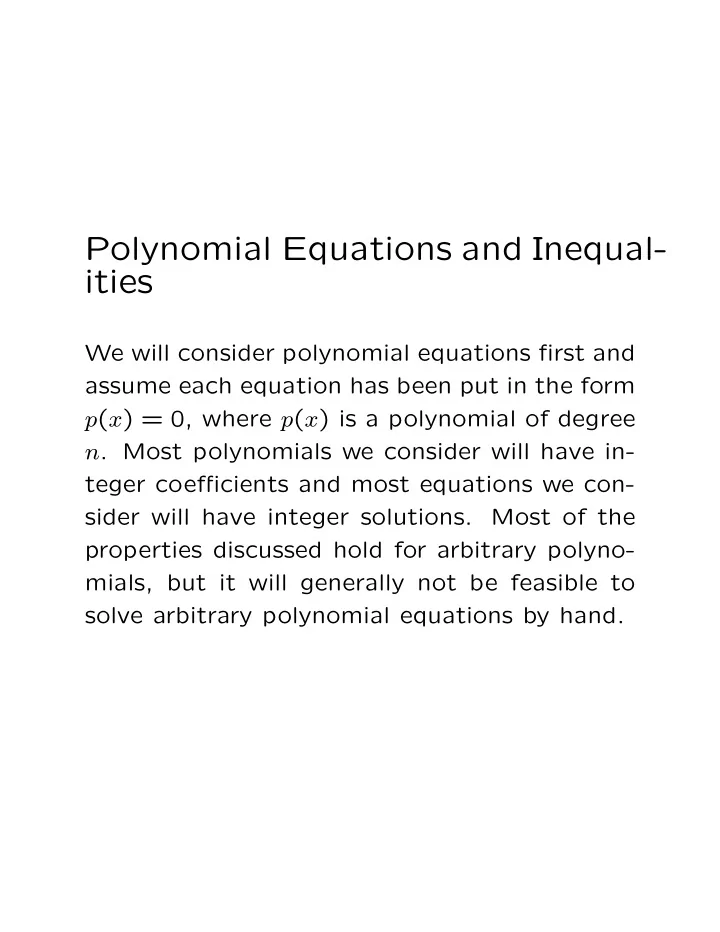

Polynomial Equations and Inequal- ities We will consider polynomial equations first and assume each equation has been put in the form p ( x ) = 0, where p ( x ) is a polynomial of degree n . Most polynomials we consider will have in- teger coefficients and most equations we con- sider will have integer solutions. Most of the properties discussed hold for arbitrary polyno- mials, but it will generally not be feasible to solve arbitrary polynomial equations by hand.
Key Properties: • x − r is a factor of p ( x ) if and only if r is a solution of the equation p ( x ) = 0. Equiva- lently, x − r is a factor of p ( x ) if and only if r is a zero of p ( x ) . • If p ( x ) is a polynomial with integer co- efficients and r is an integer solution of p ( x ) = 0, then r must be a divisor of the constant term of p ( x ). These properties lead to a strategy for solving polynomial equations. It will always work pro- vided the polynomial has integer coefficients and the solutions are integers.
Strategy We assume the equation is in the form p ( x ) = 0 and p ( x ) has integer coefficients. 1. Check all the divisors of the constant term of p ( x ) until you find a solution r . 2. Factor p ( x ) = ( x − r ) p ∗ ( x ). 3. Continue the same way, now with p ∗ ( x ), until p ( x ) has been factored completely. 4. Pick out all the solutions of the equation p ( x ) = 0. Once p ( x ) has been factored completely, you should be able to find the solutions at sight.
Once you have a factor x − r of p ( x ), one can factor in any way one prefers. As a last resort, one can always use long division to find p ( x ) x − r and factor p ( x ) = ( x − r ) · p ( x ) x − r . Special Cases Linear and quadratic equations are special cases. The strategy given will work in those cases, but it’s probably overkill – especially for linear equations. Remember: If you ever see anything special you can make use of, do so. Very often, a problem can be solved routinely but can be solved more easily if one observes a special cir- cumstance.
Polynomial Inequalities Everything learned about solving polynomial equations applies to polynomial inequalities; poly- nomial inequalities just require a few more steps. A polynomial inequality may be written in the form p ( x ) R 0, where R is one of < , ≤ , > , ≥ . Procedure 1. Use the strategy for solving an equation to factor p ( x ) completely, writing p ( x ) = ( x − r 1 )( x − r 2 ) · · · ( x − r n ). For convenience, we will assume r 1 < r 2 < · · · < r n . 2. Recognize the zeros of p ( x ), r 1 , r 2 , . . . , r n , divide the real line into n + 1 intervals. 3. Consider each interval separately. On each interval:
(a) Analyze the sign of each factor x − r k . (b) Use these signs to determine the sign of p ( x ) on that interval. (c) Determine whether the points in that interval are in the solution set of the inequality. 4. Determine which, if any, of the zeros r 1 , r 2 , . . . , r n are in the solution set. 5. Put everything together and write down the solution set.
Recommend
More recommend